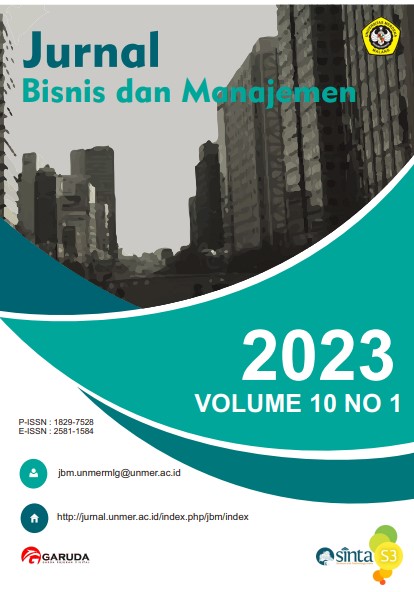Governance and Profitability in Value of Family Companies in the Manufacturing Sector
DOI:
https://doi.org/10.26905/jbm.v10i1.9364Keywords:
Tobin’s Q, size of the board of directors, audit committee size, and ROAAbstract
The general purpose of the companies are to increase their value. The value is important because it reflects investors' perceptions of the company's performance. This study aims to examine the effect of the size of the board of directors, the size of the audit committee, and ROA (Return on Assets) on Tobin's Q. The sample used in this research is family companies that categorize in the Manufacturing sectoral from 2015-2019. The results showed that profitability had a positive effect on firm value. However, the size of the board of directors has a negative effect on firm value. It is possible that a smaller board of directors may be more active in coordinating and communicating than a larger number of directors. In addition, a more limited number of directors can improve company performance because consensus in decision making and communication becomes more effective.
Downloads
References
Anderson, R. C., & Reeb, D. M. (2003). American Finance Association Founding-Family Ownership and Firm Performance : Evidence from the S & P 500 Authors (s): Ronald C . Anderson and David M . Reeb Published by : Wiley for the American Finance Association Stable URL : http://www.jstor.org/sta. The Journal of Finance, 58(3), 1301–1328.
Andres, C. (2008). Large shareholders and firm performance-An empirical examination of founding-family ownership. Journal of Corporate Finance, 14(4), 431–445. https://doi.org/10.1016/j.jcorpfin.2008.05.003
Astrachan, J. H., Klein, S. B., & Smyrnios, K. X. (2002). The F-PEC Scale of Family Influence: A Proposal for Solving the Family Business Definition Problem. Family Business Review, 15(1), 45–58. https://doi.org/10.1111/j.1741-6248.2002.00045.x
Athanassiou, N., Crittenden, W. F., Kelly, L. M., & Marquez, P. (2002). Founder centrality effects on the Mexican family firm’s top management group: Firm culture, strategic vision and goals, and firm performance. Journal of World Business, 37(2), 139–150. https://doi.org/10.1016/S1090-9516(02)00073-1
Barontini, R., & Caprio, L. (2006). The effect of family control on firm value and performance. European Financial Management, 12(5), 689–723.
Bartholomeusz, S., & Tanewski, G. A. (2006). The relationship between family firms and corporate governance. Journal of Small Business Management, 44(2), 245–267. https://doi.org/10.1111/j.1540-627X.2006.00166.x
Beiner, S., Drobetz, D. W., Schmid, F., & Zimmermann, H. (2004). Is board size an independent corporate governance mechanism? Kyklos, 57(3), 327–356. https://doi.org/10.1111/j.0023-5962.2004.00257.x
Brigham, E. F., & Hauston, J. F. (2011). Dasar-Dasar Manajemen Keuangan. Jakarta: Salemba Empat.
Chu, W. (2009). The influence of family ownership on SME performance: Evidence from public firms in Taiwan. Small Business Economics, 33(3), 353–373. https://doi.org/10.1007/s11187-009-9178-6
Ciftci, I., Tatoglu, E., Wood, G., Demirbag, M., & Zaim, S. (2019). Corporate governance and firm performance in emerging markets: Evidence from Turkey. International Business Review, 28(1), 90–103. https://doi.org/10.1016/j.ibusrev.2018.08.004
Dewanti, M. P. R. P., & Djajadikerta, H. (2018). Pengaruh Kinerja Keuangan dan Tata Kelola Perusahaan Terhadap Nilai Perusahaan pada Industri Telekomunikasi di Bursa Efek Indonesia. Jurnal Akuntansi Maranatha, 10(1), 98–116. https://doi.org/10.28932/jam.v10i1.932
Din, S., & Javid, A. Y. (2012). Impact of family ownership concentration on the firm’s performance (Evidence from Pakistani capital market). Journal of Asian Business Strategy, 2(3), 63–70. Retrieved from https://ideas.repec.org/p/pra/mprapa/37566.html
Dinah, A. F., & Darsono Darsono. (2017). Pengaruh Tata Kelola Perusahaan, Profitabilitas, Dan Penghindaran Pajak Terhadap Nilai Perusahaan. Diponegoro Journal of Accounting, 6(3), 1–15.
Donaldson, L., & Davis, J. H. (1991). Stewardship Theory or Agency Theory: CEO Governance and Shareholder Returns. Australian Journal of Management, 16(1), 49–64. https://doi.org/10.1177/031289629101600103
Donelly, R. G. (1988). The Family Business. https://doi.org/https://doi.org/10.1111/j.1741-6248.1988.00427.x
Fama, E. F., & Jensen, M. C. (2019). Separation of ownership and control. Corporate Governance: Values, Ethics and Leadership, XXVI(June), 163–188. https://doi.org/10.1086/467037
Gitman, L. J., & Zutter, C. J. (2003). Principle of Managerial Finance. Harington, USA: Pearson.
Gomez-Mejia, L. R., Nuñez-Nickel, M., & Gutierrez, I. (2001). The Role of Family Ties in Agency Contracts. Academy of Management Journal, 44(1), 81–95. https://doi.org/10.5465/3069338
Gujarati, D. N. (2003). Basic Econometrics (4th ed.). New York: McGraw-Hill.
Herrera-Echeverri, H., Geleilate, J. G., Gaitan-Riaño, S., Haar, J., & Soto-Echeverry, N. (2016). Export behavior and board independence in Colombian family firms: The reverse causality relationship. Journal of Business Research, 69(6), 2018–2029. https://doi.org/10.1016/j.jbusres.2015.10.147
Jackling, B., & Johl, S. (2009). Board structure and firm performance: Evidence from India’s top companies. Corporate Governance: An International Review, 17(4), 492–509. https://doi.org/10.1111/j.1467-8683.2009.00760.x
Jensen, M. C., & Meckling, W. H. (1995). Specific and General Knowledge, and Organizational Structure. Journal Of Applied Corporate Finance, 8(2), 4–18.
Jonchi Shyu. (2011). Family ownership and firm performance: evidence from Taiwanese firms. International Journal of Managerial Finance, 7(4), 397–411. https://doi.org/https://doi.org/10.1108/17439131111166393
Judge, G. G., Hill, C., Griffiths, W. E., Lutkepohl, H., & Lee, T.-C. (1980). Introduction to the Theory and Practice of Econometrics. New York: John Willey & Sons.
Karamanou, I., & Vafeas, N. (2005). The association between corporate boards, audit committees, and management earnings forecasts: An empirical analysis. Journal of Accounting Research, 43(3), 453–486. https://doi.org/10.1111/j.1475-679X.2005.00177.x
Lee, J. (2006). Family firm performance: Further evidence. Family Business Review, 19(2), 103–114. https://doi.org/10.1111/j.1741-6248.2006.00060.x
Mohd Saleh, N., Mohd Iskandar, T., & Mohid Rahmat, M. (2007). Audit committee characteristics and earnings management: Evidence from Malaysia. Asian Review of Accounting, 15(2), 147–163. https://doi.org/10.1108/13217340710823369
Monks, R. A. G., & Minow, N. (2003). Corporate Governance. Oxford: Blackwell Publishing.
Muhammad, A., Amedi, R., & Saeed Mustafa, A. (2020). Accounting Analysis Journal Board. Characteristics and Firm Performance: Evidence From Manufacture Sector of Jordan. Accounting Analysis Journal, 9(3), 146–151. https://doi.org/10.15294/aaj.v9i3.39577
Muttakin, M. B., & Subramaniam, N. (2012). Board Structure and Firm Performance : Evidence from an Emerging Economy. Academy of Taiwan Business Management Review, 8(2), 1–13.
Obradovich, J., & Gill, A. (2012). The Impact of Corporate Governance and Financial Leverage on the Value of American Firms. International Research Journal of Finance and Economics, (91), 1–14.
Onasis, K., & Robin. (2016). Pengaruh Tata Kelola Perusahaan terhadap Nilai Perusahaan pada Perusahaan Sektor Keuangan yang Terdaftar di BEI. Bina Ekonomi, 20(1), 1–22. https://doi.org/10.26593/be.v20i1.1893.1-22
Pearce, J. A., & Zahra, S. A. (1992). Board Composition From a Strategic Contingency Perspective. Journal of Management Studies, 29(4), 411–438. https://doi.org/10.1111/j.1467-6486.1992.tb00672.x
Pieper, T. M., Klein, S. B., & Jaskiewicz, P. (2008). The impact of goal alignment on board existence and top management team composition: Evidence from family-influenced businesses. Journal of Small Business Management, 46(3), 372–394. https://doi.org/10.1111/j.1540-627X.2008.00249.x
Rock, S. (1991). Family Firms. England: Director Book-Simon Schuster.
Saito, T. (2008). Family firms and firm performance: Evidence from Japan. Journal of the Japanese and International Economies, 22(4), 620–646. https://doi.org/10.1016/j.jjie.2008.06.001
Sari, G. M. (2014). Pengaruh Corporate Governance Dan Kompensasi Rugi Fiskal Terhadap Tax Avoidance: Studi Empiris Pada Perusahaan Manufaktur yang Terdaftar Di BEI. Jurnal Wahana Riset Akuntansi, 2(2), 491–512. https://doi.org/https://doi.org/10.24036/wra.v2i2.6157
Sindhuja, P. N. (2009). Performance and Value Creation: Family Managed Business versus Non-Family Managed Business. IUP Journal of Business Strategy, 6.3(4), 66–80.
Sukandar, P. P., & Rahardja, R. (2014). Pengaruh Ukuran Dewan Direksi dan Dewan Komisaris Serta Ukuran Perusahaan Terhadap Kinerja Keuangan Perusahaan (Studi Empiris pada Perusahaan Manufaktur Sektor Consumer Good yang Terdaftar di BEI Tahun 2010-2012). Diponegoro Journal of Accounting, 3(3), 1–7.
Susanto, A. (2007). A Strategic Management Approach: Corporate Social Responsibility. Jakarta: The Jakarta Consulting Group.
Utomo, F. M., & Dianawati, W. (2017). Corporate Governance Dan Leverage Terhadap Nilai Perusahaan Dengan Kualitas Laba Sebagai Variabel Mediasi. Jurnal Investasi Islam, Vol.2(No.2), pp: 21-44.
Veronica, T. M., & Wardoyo. (2013). pengaruh good corporate governance, CSR dan Kinerja keuangan terhadap Nilai Perusahaan. Jurnal Dinamika Manajemen, 4(2), 132–149. Retrieved from http://journal.unnes.ac.id/nju/index.php/jdm
Westhead, P., & Howorth, C. (2006). Ownership and management issues associated with family firm performance and company objectives. Family Business Review, 19(4), 301–316. https://doi.org/10.1111/j.1741-6248.2006.00077.x
Widyaningdyah, A. U. (2001). Factors Analysis Affecting Earnings Management on Go Publuc Companies in Indonesia. Jurnal Akuntansi, 3(2), 89–101. https://doi.org/https://doi.org/10.9744/jak.3.2.pp.%2089-101
Yammeesri, J., & Lodh, S. C. (2004). Is family ownership a pain or gain to firm performance? Journal of American. Academy of Busines, 4(1–2), 263–270.
Downloads
Published
How to Cite
Issue
Section
License
Authors who publish with this journal agree to the following terms:
(1) Copyright of the published articles will be transferred to the journal as the publisher of the manuscripts. Therefore, the author confirms that the copyright has been managed by the journal.
(2) Publisher of Jurnal Bisnis dan Manajemen is University of Merdeka Malang.
(3) The copyright follows Creative Commons Attribution–ShareAlike License (CC BY SA): This license allows to Share — copy and redistribute the material in any medium or format, Adapt — remix, transform, and build upon the material, for any purpose, even commercially.














